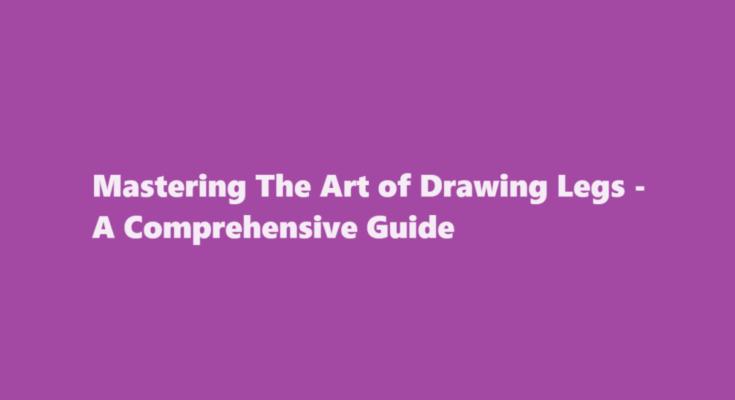Introduction
Drawing legs is an essential skill for artists, whether you are a beginner or an experienced illustrator. Legs, with their intricate anatomy and graceful lines, can be challenging to depict accurately. However, with practice and a solid understanding of leg anatomy, you can create captivating and lifelike leg drawings. In this article, we will explore the step-by-step process of drawing legs and provide you with valuable tips and techniques to help you improve your leg-drawing skills.
Understanding Leg Anatomy
Before you begin drawing legs, it’s crucial to have a fundamental understanding of leg anatomy. The human leg is divided into two main parts: the thigh and the calf. The thigh is the upper part of the leg, while the calf is the lower part. Both the thigh and calf have distinct muscles, joints, and bone structures.
Start with Basic Shapes
To draw legs, start with basic shapes. Begin by sketching an elongated oval for the thigh and a smaller oval for the calf. These ovals will serve as your framework for the legs and help you establish the proportions and orientation.
Define the Leg Length
Determine the length of the legs in your drawing. Pay attention to the proportions of the thigh and calf relative to the rest of the body. Legs can vary in length, so adapt them to your specific subject or character.
Add the Knee Joint
Locate the midpoint of the thigh and mark it as the knee joint. Draw a small circle to represent the knee. The knee joint is a pivotal point in leg anatomy, as it enables bending and flexibility.
Detail the Thigh
The thigh is a complex area with several muscles. To capture its form, add curves and lines to your thigh oval, keeping in mind the muscle structure. Some of the key muscles to consider are the quadriceps on the front and the hamstrings on the back. Study anatomy references to understand these muscles better.
Outline the Calf
Moving down to the calf, add contour to the calf oval, focusing on the calf muscle (gastrocnemius). This muscle gives the calf its characteristic shape and bulge. The calf tapers towards the ankle, which you should represent in your drawing.
Define the Ankle
The ankle is the joint that connects the calf to the foot. It is a crucial point in leg anatomy. Draw a small circle or oval to represent the ankle. The ankle’s size and shape can vary, so adapt it accordingly.
Draw the Foot
The foot is the final part of the leg. It can be a complex structure, but for a basic leg drawing, you can represent it with a simple shape, like an elongated oval. Pay attention to the orientation of the foot, as it can be flexed, pointed, or rotated.
Add Toes and Details
If your subject is barefoot, add toes to the foot. Keep in mind that toes vary in size and shape. Toes should be positioned realistically based on the foot’s orientation.
Refine and Shade
Once you have the basic leg structure, refine your drawing by adding details, such as muscle definition and contours. Pay attention to light and shadow, as shading can enhance the three-dimensional quality of your drawing. Highlight the areas that receive the most light and shade the recessed areas.
Tips for Drawing Realistic Legs
1. Study Anatomy: Invest time in studying leg anatomy through anatomy books, online resources, or even life drawing classes. A solid understanding of the underlying structures is key to drawing legs convincingly.
2. Observe Real Life: Observe people’s legs in various poses and situations. This will help you grasp the diversity of leg shapes and movements.
3. Practice Gesture Drawing: Gesture drawing is an excellent exercise for capturing the essence and movement of legs quickly. It helps you become more adept at drawing dynamic poses.
4. Use References: Don’t hesitate to use reference images as you practice. They can provide valuable insights into leg anatomy and proportions.
5. Experiment with Different Styles: Try different drawing styles, from realistic to stylized. Experimenting will help you find your unique approach to drawing legs.
6. Keep Proportions in Mind: Pay attention to the proportions of the legs in relation to the rest of the body. A common mistake is drawing legs too long or too short.
FREQUENTLY ASKED QUESTIONS
Why are legs so attractive?
Men self-purported to have crurophilia tend to view the legs as the most attractive part of the female body because of their seductively-teasing nature. Whereas display of the breasts and buttocks is considerably “in your face”, presentation of the legs offers more control over how much and for how long.
Do girls look at legs?
Women prefer a man with legs that are about half his height, according to previous research; scientists believe that is an evolutionary result of women wanting to choose only healthy men. Legs that are too short, for example, have been linked to type 2 diabetes.
Conclusion
Drawing legs can be a challenging yet rewarding endeavor for artists. By understanding leg anatomy, starting with basic shapes, and following a step-by-step approach, you can improve your leg-drawing skills. With practice and attention to detail, you’ll be able to depict legs realistically and convey their unique beauty in your artwork. So, grab your sketchbook, and start honing your leg-drawing skills today!
Read Also : Patience and Persistence – How Long Does It Take for Wellbutrin to Work



